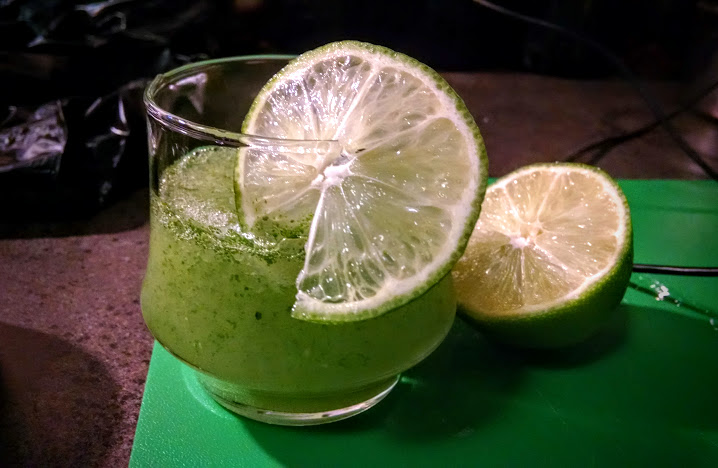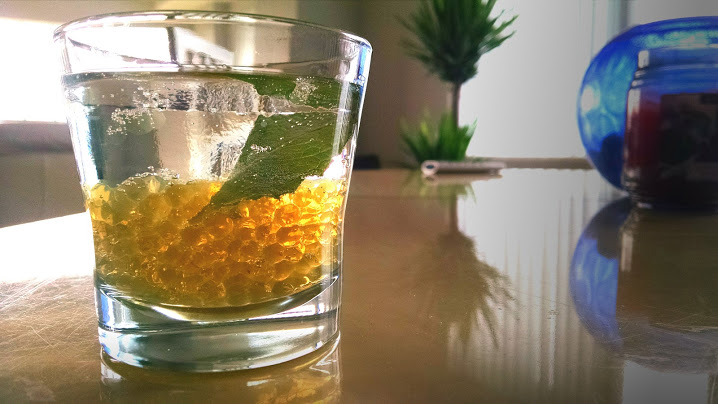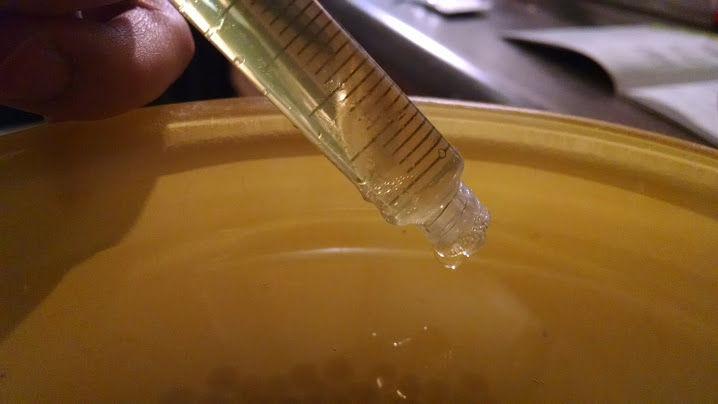Mojitos
Molecular gastronomy is a neat crossover of chemistry and food science — the sort of thing that you generally scoff at in overpriced Manhattan restaurants. I won’t go into the specifics, since this Wikipedia article does a far better job. But after a brief mojito stint in Los Cabos a few months ago, I decided to embark on a quest to make The Most Interesting Mojito Ever.
Here’s my work so far. (Scroll to the bottom for an interesting brief on why alcohol burns, and why these cocktails don’t.)
The Blended Mojito
 Certainly not the most interesting, but definitely a good place to start. Here’s my recipe:
Certainly not the most interesting, but definitely a good place to start. Here’s my recipe:
Blended Mojito
- Juice one large lime into two jiggers of white rum (3oz total, or 90mL). In my experience, the best way to juice a lime is by having someone else do it.
- Add one jigger of sugar and 4-6 fresh mint leaves. Seven or eight will do fine in a pinch.
- Blend with a handful of ice-cubes until of slushy consistency.
- Apply orally as needed.
I like to garnish with a slice of lime on the rim.1
The Molecular Gastronomy Mojito

Science! Mojito
- Blend 1 cup sugar, 2 cups water, and five or six sprigs of mint (20-30 leaves).
- Bring the mixture to a simmer, and then strain.
- Add 2g of sodium alginate (often used to stabilize or emulsify foods like ice cream or jam) and mix thoroughly. I use a blender which is probably a bad idea because next,
- Let sit until there are no air bubbles in the mixture. (To expedite, I normally skim off the foam, which is kinda fun to top the final drink with anyhow.) The cooler the mixture, the better this will go.
- Dissolve 2g calcium lactate in three cups of water. Put this in a bowl that can hold at least four cups.
- Okay. Put on your patience hat. Or…go grab ten friends. Everyone gets a syringe. No needles, thank you.
- Using a syringe or eyedropper (yes seriously), drip the sodium alginate mixture into the calcium lactate mixture. When the alginate touches the lactate, the two undergo a process known to molecular gastronomists as ‘reverse spherification’, and they form what looks like caviar. Liquid sweet-mint-juice on the inside, a membrane on the outside.
- Serve in a chilled glass with one shot white rum and filled with club soda. (The club soda is optional, but it makes the caviar sink and float, which is good because otherwise you get all rum at the beginning of the drink and all sugar-mint at the end.)
Spherification works because the polysaccharide sodium alginate gels only in the presence of Ca2+, which we supply in the form of the (comparatively) weakly-bound calcium lactate.2
Oh hey — here’s a neat picture of me using a 5mL syringe to move two cups of liquid. So… Somewhere around 100 back-and-forths. It reminds me of endless micropipetting in the genetics lab. Except I rarely ate the synthetic DNA.

Why Alcohol Burns (and Why These Cocktails Don’t)
You taste things because the molecules in the food interact with specialized cells in your mouth — taste-receptors — that react to different kinds of compounds. Then those receptors transmit that information to the brain. For instance, a certain kind of taste receptor, called an ENaC, detects salty food by reacting to the sodium in salt. Another detects sweet food, and yet another detects bitter… You get the point.
Humans also have a receptor called TRPV1. (People pronounce it, ‘trip-V1’). TRPV1 is all over the body, and it helps to tell you what temperature things are: Did you just put your hand on the hot stove? TRPV1 receptors fire off signals to the nervous system to inform you of the heat so you can react.3
TRPV1 ‘heat sensors’ are all over the mouth and throat, too; they help us to determine if the food we’re eating is too hot. This receptor normally responds to temperatures over 110° F. But if you add drinking-alcohol (ethanol) or another compound called capsaicin — that’s right, like you find in hot chili peppers — the TRPV1 starts responding to temperatures lower than 110° F. In other words, you’re being “burned” by things that aren’t actually hot. That’s why chili peppers and alcohol feel like they’re burning.
Oh, and iced cocktails like the blended mojito? They lower the temperature enough that, at least in some cases, the TRPV1 doesn’t react at all. The result is a nice, smooth, cool refreshing way to get absolutely smashed.
That’s why you always put your crappy vodka in the freezer.
Alcohol tricks the body’s heat receptors into thinking it’s getting too hot. Icing your alcohol lessens this effect.
-
I don’t bother garnishing with mint — it just tickles your nose and gets in the way. ↩
-
Naturally, this would work with any cation, but calcium happens to be not awful for you to eat, and it’s cheap to get your hands on. ↩
-
TRPV1s also help you determine if you just stuck your hand in a vat of acid, too: It’s very talented. (That’s why acid burns feel like regular burns — at least at first.) ↩